SUMMER SALE - USE CODE: "SUMMER50"
50% OFF YOUR COURSE
CAPTURE THE MILKY WAY & BENRO POLARIS COURSE
You missed out!
75+ VIDEO LESSONS | 27+ HOURS OF CONTENT
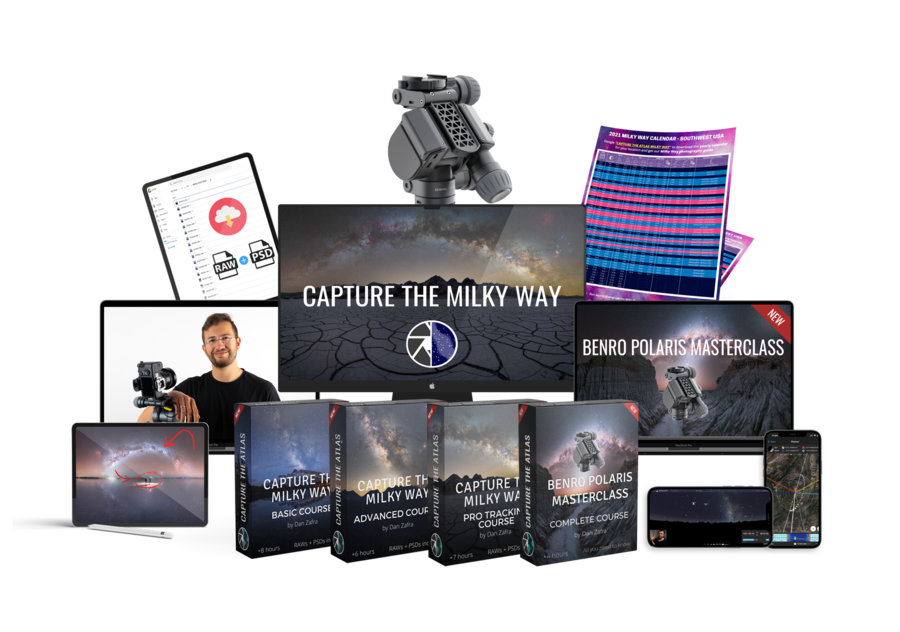
Any modern digital camera will have camera metering modes, which are fundamental to getting right exposure in your images.
Also called exposure metering or just “metering”, camera metering is one of the key steps you need to do before taking a picture, and knowing the different camera metering modes will allow you to select the best settings for your shot.
In this guide to camera metering modes in photography, we’ll dive not only into what are the different metering modes, but also how to use metering modes according to the genre and subject that you are shooting.
I’ll also break down the different camera metering modes and symbols by manufacturer, as well as offer some camera metering mode tips and examples so you can confidently choose between matrix metering vs. spot metering or any other metering mode.
Are you ready to understand metering modes in digital photography?
- What is a metering mode?
- Matrix/Multi/Evaluative metering mode
- Center-Weighted metering mode
- Spot metering mode
- How to change your camera metering mode
- Camera metering mode symbols chart by manufacturer
- What is the best metering mode? Camera metering mode examples
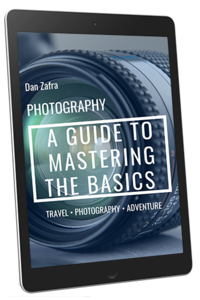
GET OUR FREE EBOOK TO
MASTER THE PHOTOGRAPHY BASICS
20 LESSONS AND 80+ PAGES WITH EXAMPLES, INFOGRAPHICS, TIPS, AND MORE!
What is a metering mode?
Metering modes are defined as the way your camera measures the light of the scene.
Today, DSLR and mirrorless cameras’ metering modes systems are based on a built-in exposure meter that, when you point your camera at your subject, help you read the available light so you can decide which are the best exposure settings. The process of measuring the light is a topic that we cover in-depth in our guide to understanding light metering in photography.
Depending on the camera metering mode you select, your camera will use bigger or smaller areas of your frame to determine the exposure value according to your aperture, shutter speed, and ISO settings.
If you are using an auto or semiauto mode, your digital camera will automatically set the exposure settings, taking into account the calculation of the light meter, so it’s important to choose the right metering mode so your camera auto modes can make the best exposure calculation.
However, it’s also very important when you are shooting in manual since it will point out if your photo will be under or overexposed before even taking the picture, which helps you set the right settings.
You can find more information about the best shooting modes for digital cameras.
Throughout this article, we’ll see camera metering modes explained in-depth, but to name them, these are the main camera metering modes in photography:
- Multi/Matrix metering: This metering mode evaluates the light of the entire scene by dividing the frame into different zones.
- Center-weighted metering: The camera uses the center of the frame to calculate the light of the scene.
- Spot metering: This is the most specific metering mode, where the camera uses a single focus point to read the light.
Now we’ll see in greater detail how metering modes work and when you should use them.
Camera metering modes – How to use metering modes
Besides the main camera metering modes explained above, there are more metering modes depending on the manufacturer and even on the camera model.
Also, similar to focus modes, each manufacturer uses different names and metering mode symbols. For example, metering modes in Nikon vary slightly from metering modes in Canon. However, the way camera metering modes work is practically the same regardless of the digital camera.
The goal is to understand how to use the different DSLR and mirrorless metering modes and, if you don’t know which is the nomenclature/symbol in your model, don’t worry. Below, you’ll find a chart where you can easily find the metering modes on your camera.
Matrix metering mode/Evaluative metering/Multi Metering mode
Matrix metering mode is the most popular metering system. It’s the easiest to understand but also the most confusing in terms of names since each manufacturer uses different nomenclature for this mode.
Apart from Matrix meter, it’s also known as “Zone metering mode” or “Multi-segment metering”
What is matrix metering mode?
The way matrix metering mode works is by evaluating the light by dividing the frame into different areas or zones.
The camera measures the brightness of each area and provides the final exposure value, calculating an average of the different analyzed zones.
Each camera uses different zones and algorithms to run this process, analyzing different values like light and shadows, colors, distance, etc. All of them consider the focus point as an important factor in the averaging calculation.
When to use matrix metering?
Matrix/Multi metering is the camera metering mode set by default in most digital cameras and it works pretty well in all general light situations.
The main drawback of this metering mode is that your camera can underexpose or overexpose the scene when there’s a predominance of black or white.
It’s the most common metering mode for doing landscape photography, cityscapes, and scenes where there are different individuals, like in group shots.
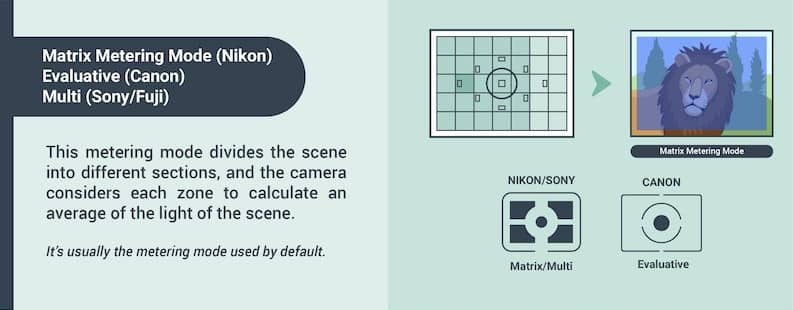
Matrix Metering Mode
Metering modes in camera nomenclature:
- Nikon metering mode: Matrix metering mode
- Canon metering mode: Evaluative metering mode
- Sony metering mode: Multi-segment metering mode
Center-weighted metering mode
The second metering system is Center-weighted metering mode. This name and icon are similar across the main manufacturers, and it’s a useful metering mode in some situations.
What is center-weighted metering mode?
Center-weighted uses the center of the frame as the reference area to calculate the light of the scene.
When comparing center-weighted vs. matrix metering, our focus point doesn’t matter in this mode; the camera will always use the center of the frame to evaluate the light, offering more consistent results from image to image.
When to use center-weighted metering mode?
There are some situations where center-weighted is recommended, such as when your subject is in the middle of the frame.
A good example is a headshot portrait where the light in the background is significantly different from your subject. If you want to get the best exposure value in your subject, center-weighted will offer the best calculation.
Spot metering mode
Spot metering mode is the last and most specific metering mode in photography. Just like center-weighted, the name and icon are very similar in most cameras.
What is spot metering mode?
Spot metering mode uses a single focus point to calculate the light. The size of this spot changes depending on the camera model but it usually ranges between 1-5% of the entire scene.
Most cameras allow you to manually select your spot metering mode by simply moving your focus point. Some cameras also allow you to choose the size of the spot, like in the new Sony camera models where you can decide between a Standard or Large spot metering.
When comparing spot metering vs. center-weighted or matrix, this is the most precise metering mode.
When to use spot metering mode?
Spot metering is the least used camera metering mode but there are some situations where using it is a must, like when your subject (or the most important area of your subject) occupies a very small area in the frame.
The best example to understand spot metering mode is photographing the moon at night. Unless you’re using a telescope, the moon will occupy a small section of the frame against a black or darker background, so to make sure that the exposure is correct, we have to use spot metering mode and focus on the moon.
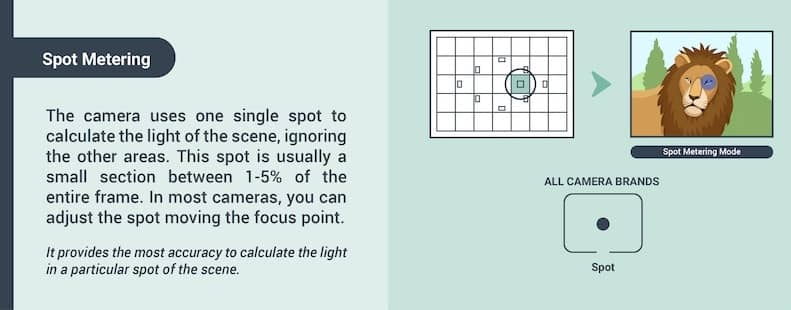
Spot Metering Mode
Partial metering mode (Specific Canon metering mode)
Partial metering mode is a Canon metering mode used specifically for their camera models.
It’s essentially a “bigger” spot metering mode, where the target area to calculate the light is around a 10-15% instead of the 1-5% most cameras use in spot metering.
If you’re using the Canon metering modes, you can see mode details of how partial metering mode works in this article.
How to change your camera metering mode
Changing the camera metering mode varies not only depending on the manufacturer but also model by model, as we said in our article on camera settings.
In entry-level cameras, you can select the camera metering mode from the main menu.
Advanced cameras usually offer quick metering mode buttons on the camera body to quickly change the mode.
In any case, I suggest checking your camera manual and getting familiar with how to change your camera metering mode.
Camera metering modes symbols chart by manufacturer
As we’ve seen so far in this metering modes tutorial, each manufacturer uses different names and symbols to describe the singular camera metering modes.
To identify your camera metering modes beyond the standard Nikon metering modes or Canon symbols, I created the following camera metering mode symbols chart by manufacturer:
What is the best camera metering mode? Metering mode examples
To help you understand not only the camera metering modes meaning but also how they work, I’ll show you which metering mode to use depending on the genre you’re shooting as well as some metering modes examples:
Best general metering mode
The best general metering mode is matrix/multi metering. It’s the metering mode set by default in most cameras for a good reason; it works effectively in most light situations.
I stick to this mode in 90% of my images, and one of the best photography tips for beginners is to start using this mode.

Matrix/Multi is the best general metering mode in photography. Maligne Lake, Canada
Best metering mode for landscape photography
The best general metering mode for landscape photography is the matrix meter/multi.
When shooting wide and vast landscapes, this metering mode allows you to calculate the average light of the main elements in your frame so you can get the perfect histogram.

Landscape shot using Matrix Metering Mode. Kirkjufell, Iceland
There are some specific landscapes where you can use center-weighted, especially when your subject is in the center of the frame with a different type of lighting.

In some situations, like this, you can use Center-weighted to calculate the light of your subject when this is different from the rest of the scene. Antelope Canyon, USA
Best metering mode for wildlife photography
Wildlife photography benefits from using all the camera metering modes depending on the situation.
For general scenes where there are different animals in the frame, matrix metering mode is the most recommended.

Matrix metering mode to capture the right exposure of this Grizzly bear and her cubs. Yellowstone NP, USA
If your subject is in the middle of the frame and the light is significantly different from the background, don’t hesitate to use center-weighted.

In this case, the subject and the eyes were in the center of the frame, so I exposed using Center-Weighted. Ubud, Bali
Lastly, if your subject occupies a tiny area of your frame, like in bird photography, spot metering mode works wonders for nailing your exposure.

Since the bird was occupying a small area of the frame, I used spot metering focusing on the bird. New Jersey, USA
Best metering mode for Portrait photography
Similar to wildlife, the best metering mode for portraits depends on the number of subjects, their position, and the available light. You can use any of the three main metering modes according to each scenario.

Center-Weighted metering mode to calculate the light in this portrait.
Best metering mode for astrophotography
For shooting pictures of the Milky Way and the stars, multi is the best metering mode. If you’re shooting Northern Lights, it can be more challenging since the lights change second by second, so unless the Aurora is “dancing” across a specific area, I’d recommend sticking to matrix metering.

Matrix Metering Mode to shoot the Milly Way. Maine, USA
Lastly, for shooting elements like the moon, spot metering mode is the best way to get the best exposure.
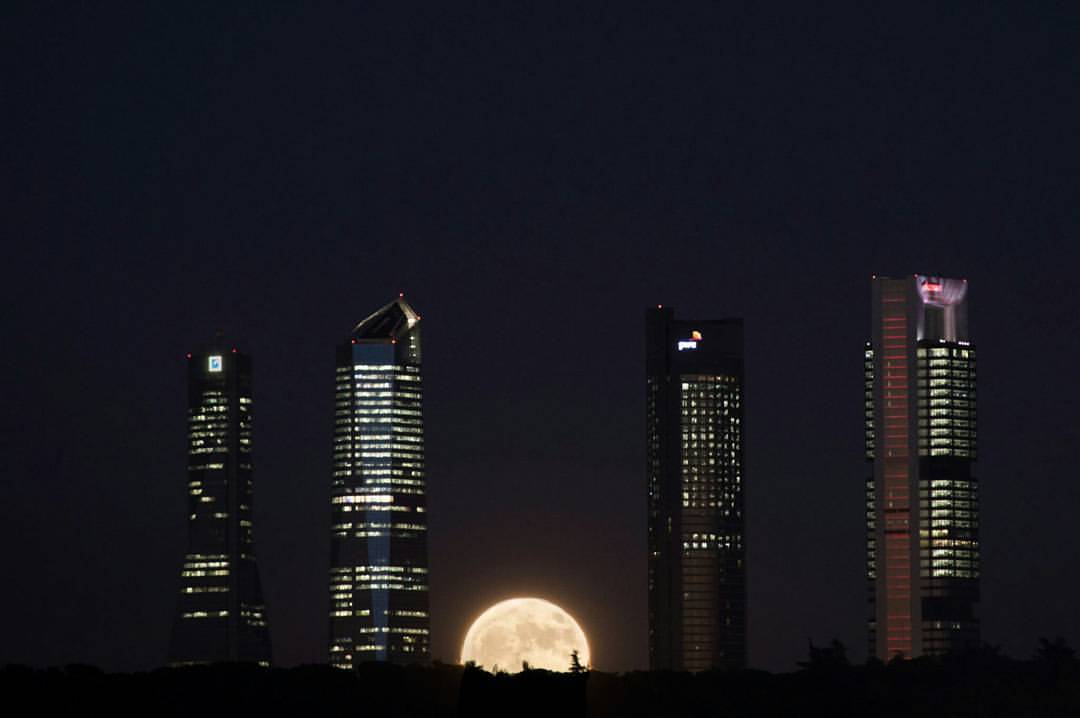
Spot Metering Mode focusing on the moon. Madrid, Spain
Best metering mode for sports photography
In sports photography, the best metering mode for general team sports is matrix metering.
If there’s a subject or group of subjects in the center of the frame, center-weighted is highly recommended.

Center-Weighted Metering mode to calculate the average light of the main subjects
If your subject is in a specific area against a bright or dark background, apart from center-weighted, you can use spot metering.

In this case, I used Spot metering again since the subject occupied a small area in the frame
Best metering mode for Macro photography
The best metering mode for macro photography is usually spot metering. In macro and other close-ups, you want to focus on the important areas of your subject, like the eyes, so using spot metering helps you calculate the best exposure over those elements.

Use spot metering mode to have the best exposure in the eye of the turtle on this close-up shot.
Camera metering modes F.A.Q
Conclusion
I hope this metering modes tutorial has helped you understand the main metering modes and metering systems in photography.
Learning how to use the metering modes is as important as the metering modes definition, and the only way to make sure that you’re selecting the best settings on your camera to get the best exposure.
To understand camera metering modes better, as well as the difference between the main modes like spot metering vs. center-weighted, I recommend reviewing the best metering mode examples described above and to practice shooting different subjects as much as you can.
If you can’t find your settings, in our metering mode chart you’ll find not only the metering modes in Nikon, Canon, and Sony, but also the metering modes in other camera brands like Fuji, Panasonic, and Pentax.
I highly recommend reading our light metering in photography guide and downloading our beginner’s PDF photography guide.
If you have any questions related to camera metering modes, please leave them in the comments below!

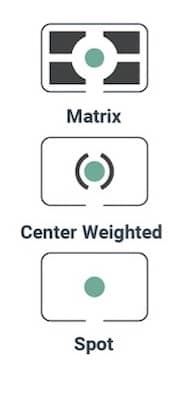


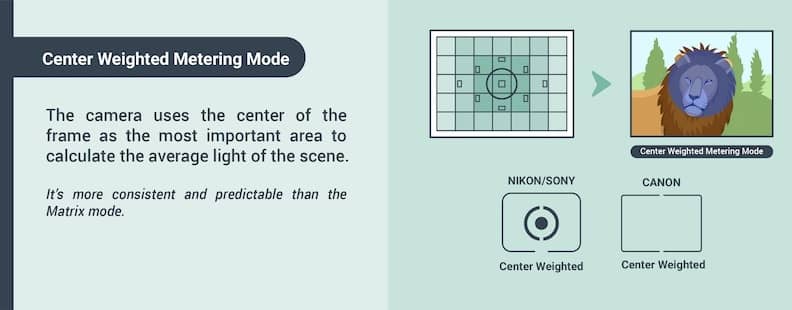
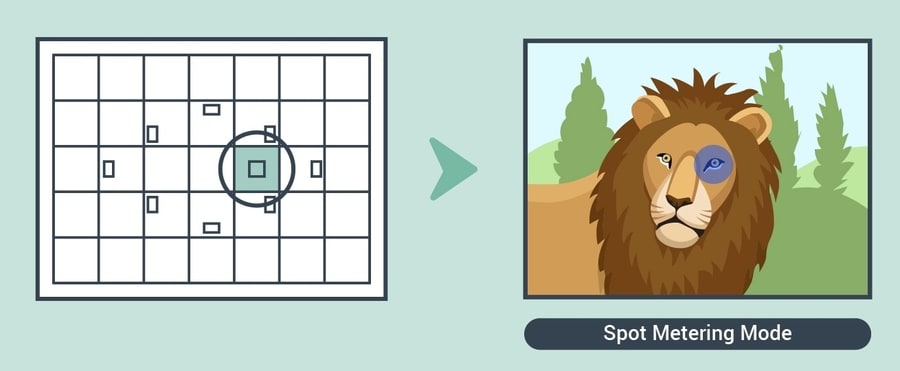
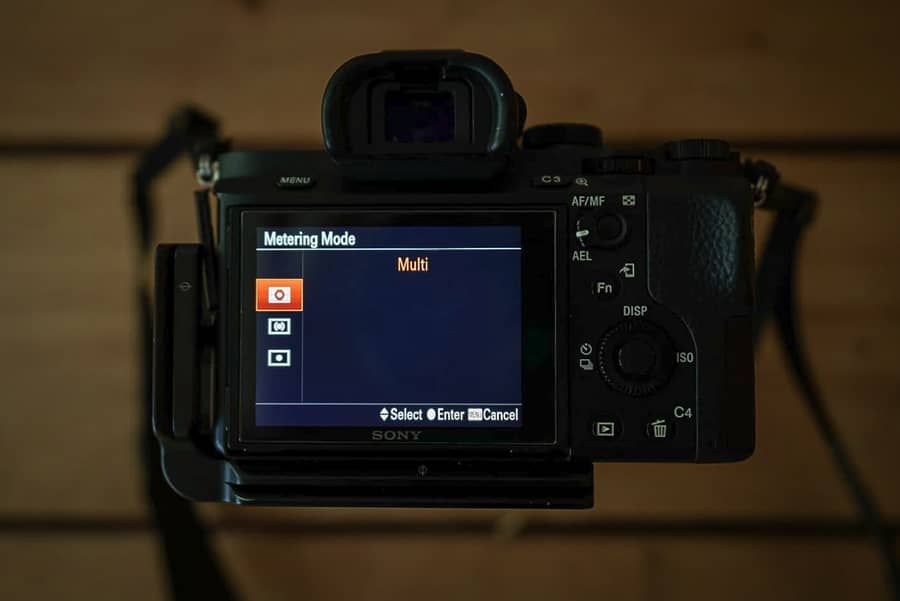
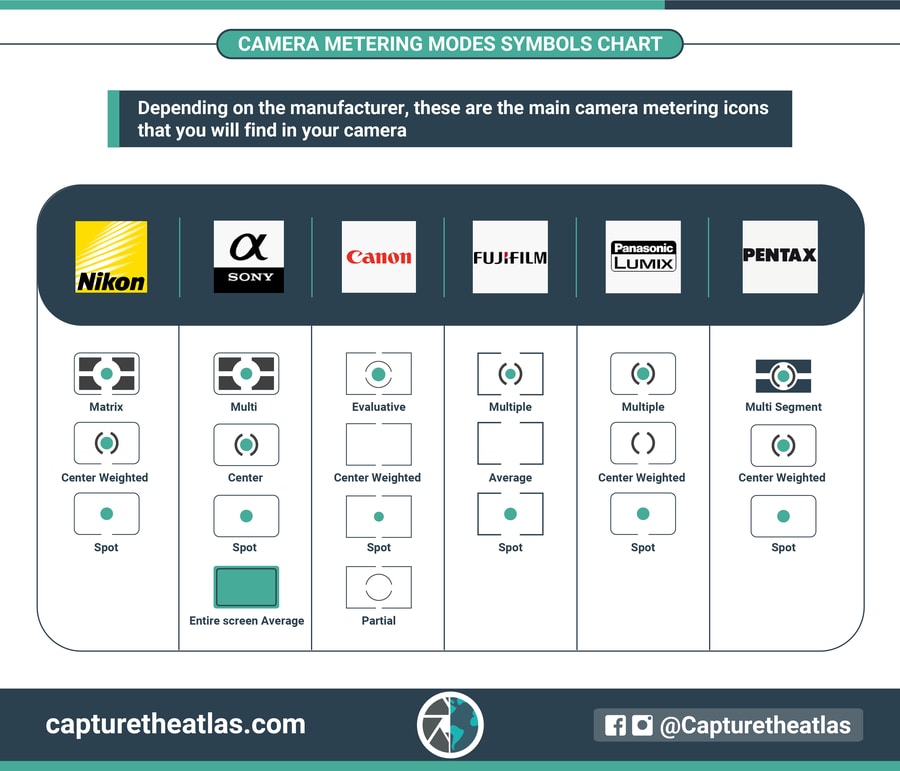








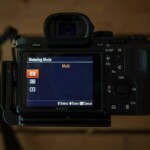
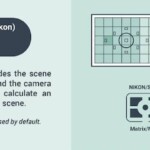

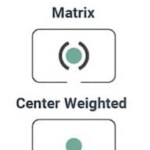


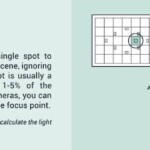









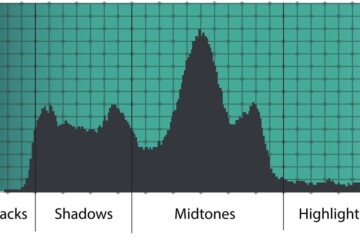
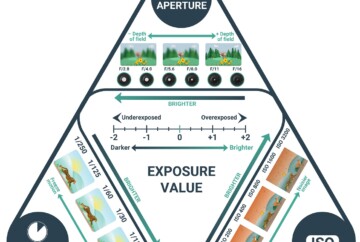







Hello!
Even my Nikon D810 has the Highlight-weighted metering mode for metering on the brightest part of the frame to expose as middle gray on the picture.
Nikon is better on the underexposed images, Canon is better on overexposed images. You did not mentioned the Nikon specific mode to get the best of the brand’s capabilities, so what about Canon? Really they not have a brand specific metering mode to expose the shadows?
Hi Zsolt, you’re right, Canon doesn’t have any specific metering mode to expose the shadows.
Great article, as a beginner when using multi metering, can you use it with any af area, multi, centre or spot thanks
Richard,
Yes, you can combine any af mode with multi metering 😉
My Nikon Zfc also has highlight-weighted metering available. It seems like a good option for dynamic high-contrast scenarios, where the subject may not fall into a predefined area, and where applying AE lock isn’t convenient.
I haven’t tried that, Mike, but thanks for sharing this information!
Best,
Dan
very instructive and easy to understand
thank you! I’m happy to see you found it helpful!